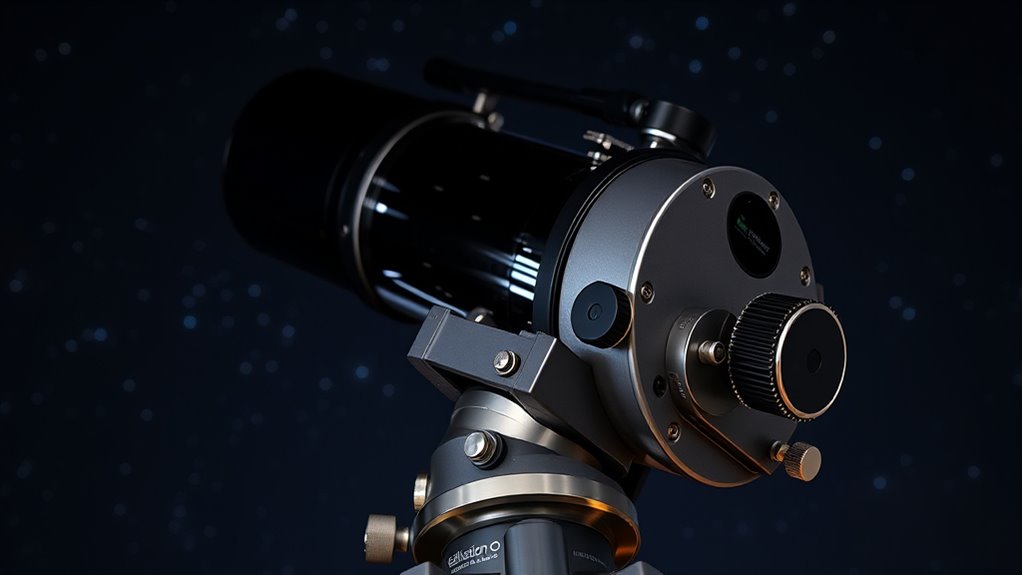If you’re looking for the best equatorial mount with a belt drive system for precision astrophotography, I recommend considering options that offer smooth, backlash-free tracking, and excellent stability. Belt drives reduce gear noise and wear, resulting in smoother long exposures and sharper images. Mount stability features like sturdy tripod legs and quality materials also matter. If you continue exploring, you’ll uncover the top models that blend these qualities for outstanding astrophotography results.
Key Takeaways
- High-end belt drive mounts like the iOptron CEM70 or Sky-Watcher EQ8-R Pro offer superior tracking accuracy for astrophotography.
- Look for mounts with precise calibration features, dual-axis clutches, and stability-enhancing materials for consistent long-exposure imaging.
- Choose models supporting wireless control and software compatibility (ASCOM, INDI) for streamlined setup and remote operation.
- Consider mounts with reinforced frames and wide-footprint tripods to minimize vibrations during extended exposures.
- Prioritize mounts with reliable power options and firmware update capabilities to maintain optimal performance over time.
iEXOS-100-2 PMC-Eight Astrophotography Tracker System with Tripod and Mount
If you’re an amateur astrophotographer looking for a budget-friendly yet capable equatorial mount, the iEXOS-100-2 PMC-Eight system is an excellent choice. It features eight CPUs for quick responsiveness, WiFi and Bluetooth connectivity, and an intuitive app for star alignment and control. The mount’s quiet belt drives and smooth axes help achieve sharp images with minimal star trails. While its tripod legs may need tightening and lack azimuth adjustment, overall, it’s portable and easy to operate. Perfect for guiding lightweight telescopes, it offers good performance at an affordable price, making it a solid option for those starting their astrophotography journey.
Best For: amateur astrophotographers seeking an affordable, portable equatorial mount with smart control features for guiding lightweight telescopes.
Pros:
- Responsive eight-CPU system offers quick star alignment and navigation.
- Quiet belt drives and smooth axes enable sharp, minimal-trail images.
- WiFi and Bluetooth connectivity with an intuitive app simplify operation and control.
Cons:
- Tripod legs may be loose initially and are not the sturdiest, affecting stability.
- Lacks azimuth adjustment, requiring modifications or accessories for precise polar alignment.
- Firmware and connectivity issues can be challenging, and some users experience off-target GoTo performance.
Factors to Consider When Choosing Equatorial Mounts With Belt Drive Systems

When selecting an equatorial mount with a belt drive, I focus on its precision and stability to guarantee clear, sharp images. I also consider how easy it is to set up and operate, along with power needs and compatibility with my equipment. These factors help me choose a reliable mount that suits my astrophotography goals.
Belt Drive Precision
Ever wondered why belt drive systems are preferred for precise astrophotography? The answer lies in their ability to reduce backlash and gear noise, resulting in smoother, more accurate tracking. The elasticity of belts allows for a more consistent transfer of motion, which boosts overall pointing accuracy. However, proper tensioning is essential—if the belt is too tight, it can strain the mount, while too loose can cause slippage and lose precision. The quality of the belt and the rigidity of the mount’s structure also play pivotal roles in achieving high precision. Less gear backlash means better guiding stability, making belt drives ideal for long exposure astrophotography. When selecting a mount, prioritize high-quality belts, proper tension, and a sturdy frame for *superior* belt drive performance.
Mount Stability Features
Choosing an equatorial mount with belt drive systems requires careful attention to stability features that guarantee accurate tracking and clear astrophotography results. A stable mount uses a sturdy, well-balanced frame made from high-quality materials to reduce vibrations during long exposures. Dual-axis clutches and precise worm gears ensure slip-free adjustments, maintaining alignment and stability. The tripod or pier should have a wide footprint, with robust legs to prevent wobbling. Proper counterweight distribution and smooth, clutched axes help keep the mount steady while tracking objects across the sky. Additional features like dampening pads, adjustable leg braces, and reinforced joints further minimize resonance and enhance overall steadiness. These elements work together to deliver reliable, vibration-free performance essential for astrophotography.
Ease of Setup
Have you ever wondered how easy it is to set up an equatorial mount with a belt drive system? The process starts with polar alignment, which can be simplified by features like polar scopes or alignment sights. Next, you’ll need to balance the telescope on the mount, adjusting the declination and right ascension axes for smooth operation. Belt drive systems help reduce backlash and gear noise, making adjustments more straightforward. Many mounts include user-friendly calibration routines and alignment procedures, saving time and frustration. Additionally, some models feature automatic leveling, quick-release components, or integrated WiFi and Bluetooth, allowing for remote control. Overall, these design elements make setup faster, easier, and more reliable, especially important when preparing for precise astrophotography sessions.
Power Consumption Needs
Belt drive systems typically consume less power than traditional gear mechanisms due to their reduced mechanical friction. However, their overall power needs depend on the telescope’s size, weight, and the motor’s efficiency. Most belt-driven mounts operate on standard 12V power supplies, but high-torque models may require higher current capacities to function properly. During long astrophotography sessions, continuous operation can considerably increase power consumption, making reliable power sources essential. Using external batteries or power tanks can extend operating time and improve stability, especially for mounts with higher power demands. Understanding these needs helps ensure your setup remains steady and functional throughout your imaging session, reducing interruptions caused by power issues.
Compatibility Options
When selecting an equatorial mount with a belt drive system, it’s important to contemplate compatibility with your existing astrophotography setup. Many mounts support software control protocols like ASCOM, INDI, and ASIAIR, making integration with various imaging tools straightforward. Wireless connectivity options such as WiFi and Bluetooth enable you to control your mount remotely via tablets or smartphones, adding convenience. Compatibility with specific telescope models and accessories depends on payload capacity, mounting interfaces, and available adapters or dovetails. Additionally, consider power flexibility—many mounts support external batteries and AC adapters, ideal for field or observatory use. Firmware update capabilities are also essential for maintaining performance and accessing new features, ensuring your mount stays current and functional over time.
Noise Levels During Operation
Quiet operation is a key advantage of belt drive systems in equatorial mounts, making them highly desirable for astrophotographers who need stability and minimal disturbance during sessions. These systems typically operate more quietly than traditional gear setups because they engage smoothly and with less abrasion. The noise level can vary based on belt quality and tension; high-quality belts tend to produce minimal sound, which is essential for maintaining focus and reducing vibrations that could compromise image quality. Some mounts feature noise-dampening materials or design improvements to further lower operational sound. However, if a belt drive becomes excessively noisy, it might signal issues like belt slippage or improper tension, which can affect both noise levels and mount performance. Overall, quieter mounts support better astrophotography experiences.
Maintenance Requirements
Regular maintenance is crucial to keep belt drive systems functioning smoothly and accurately. I regularly inspect and adjust the belt tension to ensure precise tracking and prevent slippage. Over time, the belts and pulleys may need replacement or lubrication to reduce wear and maintain ideal performance. Proper alignment of components is essential, so I routinely check calibration to avoid tracking errors that could compromise images. Keeping dust and debris off the belts and pulleys is also important, as dirt can cause abrasion and increase noise during operation. Additionally, some mounts benefit from firmware updates or software calibration, which help compensate for mechanical wear and maintain accuracy. Staying on top of these maintenance tasks ensures my mount performs reliably during long astrophotography sessions.
Cost and Value
Choosing an equatorial mount with a belt drive system involves balancing cost against the benefits it offers. Belt drives increase a mount’s price due to their precision components and engineering complexity. However, this expense can be justified by superior tracking accuracy and reduced gear backlash, which notably improve astrophotography results. When evaluating cost, keep in mind that high-quality belt drives often require maintenance or replacement over time, affecting long-term value. Budget-friendly options may lack some features or have less robust construction, potentially limiting performance. Ultimately, the right choice depends on your specific needs and budget. Higher-end belt drive mounts tend to deliver better stability and accuracy, making them a worthwhile investment for serious astrophotographers seeking precision.
Frequently Asked Questions
How Do Belt Drive Systems Improve Tracking Accuracy?
Belt drive systems improve tracking accuracy by reducing gear backlash and minimizing vibrations, ensuring smoother, more precise movements. I notice that with belts, my mount responds more quietly and consistently, which is essential for long-exposure astrophotography. The belts provide a direct, efficient connection between motors and gears, allowing for more stable tracking of celestial objects. This enhancement helps me capture sharper images with less post-processing correction.
Are Belt Drive Mounts Suitable for Astrophotography Beginners?
Absolutely, belt drive mounts are great for beginners. Imagine smoothly gliding through the night sky, capturing crisp stars without jitter. They’re quieter, easier to set up, and require less maintenance than gear-based systems. Plus, their precision helps newcomers learn tracking fundamentals without frustration. So, if you’re starting your astrophotography journey, a belt drive mount offers a reliable, user-friendly way to enjoy breathtaking celestial images early on.
What Maintenance Is Required for Belt Drive Equatorial Mounts?
Belt drive equatorial mounts need minimal maintenance, but I recommend regularly checking the belts for signs of wear or slack. Keep the mount clean and free of dust, and lubricate the gears as needed—usually once a year or if I notice any stiffness. I also guarantee the mounting screws and bolts are tight, which keeps everything aligned properly. A little routine upkeep keeps my mount performing at its best.
How Do Belt Drive Mounts Compare in Noise Levels?
Think of a belt drive mount as a whispering breeze—quiet yet powerful. In my experience, these mounts are markedly quieter than traditional gear-driven systems, making them ideal for late-night astrophotography. The absence of metal-on-metal contact reduces noise considerably, allowing me to focus on capturing celestial beauty without distraction. If you’re seeking smooth, silent tracking, belt drive mounts are a stellar choice that won’t disturb your peaceful night sky observations.
Can Belt Drive Systems Handle Heavy Astrophotography Equipment?
Absolutely, belt drive systems can handle heavy astrophotography equipment, but it depends on the mount’s specifications. I’ve found that high-quality mounts with robust motors and sturdy frames are capable of supporting larger telescopes and accessories. It’s essential to check the weight capacity and torque ratings before investing. When properly matched, these mounts provide smooth, precise tracking even with substantial gear attached, making them ideal for serious astrophotography.
Conclusion
Choosing the right equatorial mount with a belt drive system can substantially enhance your astrophotography experience. Did you know that belt drive systems can reduce backlash by up to 50%, offering more precise tracking? This improvement means sharper images and more successful astrophotos. Investing in a quality mount like the iEXOS-100-2 can make a real difference. Ultimately, the right choice combines stability, quiet operation, and value, helping you reach new heights in capturing the cosmos.











